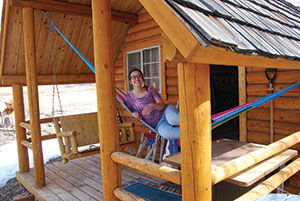OUTDOOR ED STUDENTS 'ROUGHING IT' IN PILOT PROGRAM
OUTDOOR ED STUDENTS 'ROUGHING IT' IN PILOT PROGRAM

A select group of Central Wyoming College outdoor education students are taking part in a pilot residency program at CWC’s Sinks Canyon Center as the college begins the considers permanent housing at the facility south of Lander.
Seven second-year students are living in the rustic cabins at the SCC this spring as plans come together to construct a 24-bed student residence facility at the site.
“It’s going to be a little rough at first,” said Outdoor Education Professor Darran Wells as he recalled the students moved in the day of a January blizzard.
For Connor Bailey, an outdoor education student from Evanston, living at the Sinks Canyon Center has been a “blast.”
“I love living there,” he said. “We are five minutes away from the Sinks Canyon. There are awesome hiking trails right behind us.”
While the small log cabins are barely insulated from the cold Wyoming winters and bathroom and shower facilities are at least 100 yards away, the five guys and two gals living there are content. The only drawback, Bailey said, is the lack of wireless internet and limited cell phone reception.
Wells and Ken Colovich, who oversees CWC’s Lander operations, began talking about a residency program for outdoor education students five years ago. “I saw so many outdoor learning opportunities there,” Wells said.
He is crafting the popular program to offer the first year of courses on the CWC campus so that his students, many of whom are from out-of-state, can experience the CWC campus culture. During their second year, their classes will be held at the Sinks Canyon Center. The residency program offers more hands-on, experience-based learning and provides opportunities for the students to develop more marketable skills as well as better access to outdoor activities, he explained.
“I picture us growing the number of classes out there,” Wells said, explaining the Sinks Canyon Center is an appropriate classroom facility for many subjects such as field biology, environmental sciences, cultural history, archaeology and art.
For the students living at the site now it is an adventure. “We definitely take advantage of the outdoor recreation that is here,” said Bailey. “It’s an amazing thing to wake up every morning and see Table Mountain and the Sinks Canyon out your window. I can’t believe I’m living here.”
The college hopes to have the new housing facility at the Sinks Canyon ready by next year, but the building is rather challenging. “It’s a river valley,” Wells said of the construction site. “It’s full of boulders.”
With the Sinks Canyon Center residence program, Wells hopes to see his program double in the next eight years. With increased enrollment, there will be more demand for classes not currently offered, such as caving, whitewater kayaking, and standup paddle boarding. “There are a number of things we could do with more numbers.”
It is proposed to construct the facility on the northwest side of the Popo Agie River, which will make it physically closer than the cabins are to the classroom buildings. There is no power, plumbing, natural gas or propane at the site and a road will have to be built to access it as well as a foot bridge over the river.
The design of the six four-bedroom units will be similar to the 48-bed facility the college is intending to build on campus at some time in the future. Carney, Logan, Burke, a Jackson architectural firm known for development of low-income housing, is designing the units. The overall design of the Sinks Canyon facility is expected to fit in with the natural surrounding area. The construction is being funded by revenue bonds which will be paid off through rent revenue.
For Bailey, he’s satisfied with his current living situation. “In all honesty, I wouldn’t mind living in the cabins all year,” he said, acknowledging he doesn’t need all the creature comforts of a dorm room.
Bailey is one of the few Wyoming students in the outdoor education program. After graduating from Evanston High School in 2012, he wasn’t quite ready to go to college. He took a semester-length course in New Zealand offered through the National Outdoor Leadership School in the fall and earned 12 college credits from CWC. With the college courses he earned while in high school, he had enough credits to qualify for the sophomore residency program.
He didn’t know his other cabin mates when he arrived, but in no time the small group immediately became “a real tight knit community.” Ironically, the out-of-state students have been showing the Wyoming guy the best hiking trails in the Wind Rivers.
Through a partnership with the Wyoming Catholic College, breakfast and dinners are delivered weekdays to the SCC’s Fremont Hall. On weekends, the students fend for themselves in the hall’s kitchenette.
Before there was a discussion of campus housing at the SCC, Wells looked at converting the cabins for long-term residents. “It would have been more expensive,” he said. “In the long run, the students will be a lot happier in the new residences.”
2660 Peck Avenue
Riverton, WY 82501
(307) 855 – 2000
Campus Map
120 Enterprise Blvd.
Lander, WY 82520
(307) 332 – 3394
Campus Map
240 S. Glenwood St #124
P.O. Box 4795
Jackson, WY 83001
(307) 733 – 7425
Campus Map
302 W. Ramshorn
P.O. Box 175
Dubois, WY 82513
(307) 455 – 2625
Campus Map
© 2024 Central Wyoming College – All Rights Reserved